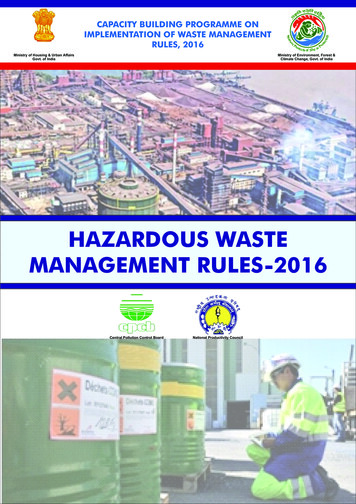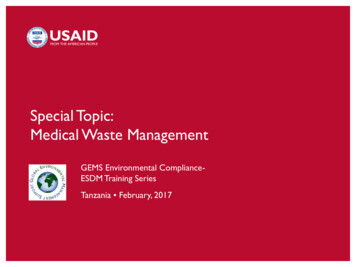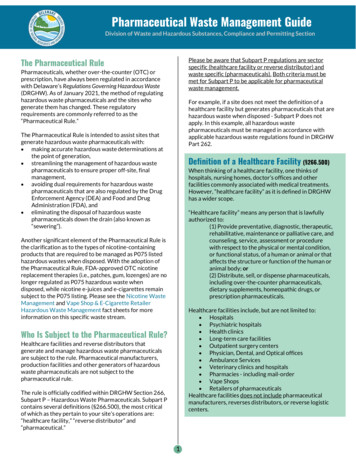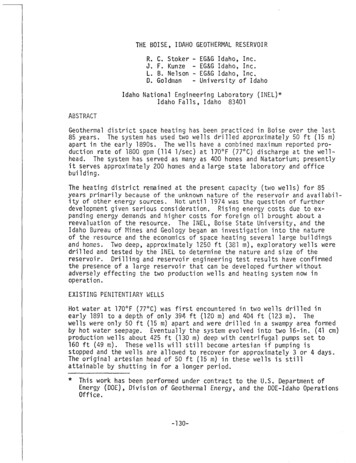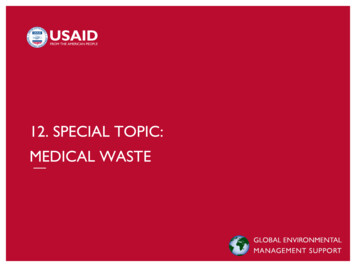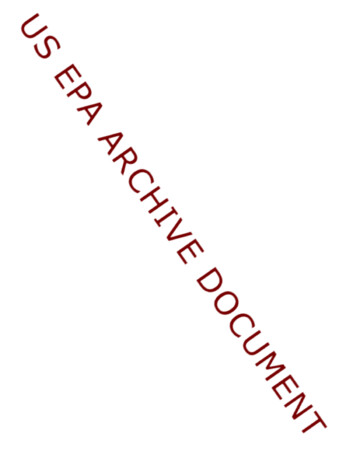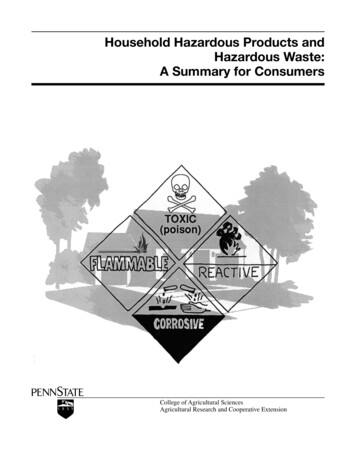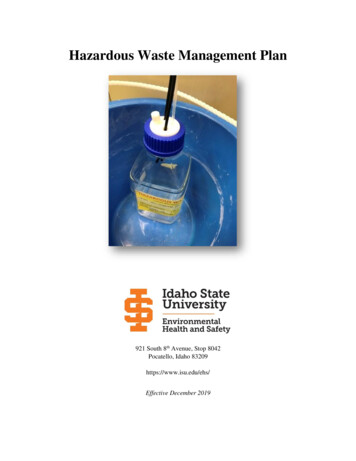
Transcription
Hazardous Waste Management Plan921 South 8th Avenue, Stop 8042Pocatello, Idaho 83209https://www.isu.edu/ehs/Effective December 2019
Hazardous WasteManagement PlanDocument Number:Date:Department:ENV-HW-MP-001December 2019Environmental Health andSafetyRecord of RevisionRevision000DateAugust December 2019Description of ChangeMajor revision of 2008 hazardouswaste management plan andprocedures.ENV-HW-Hazardous Waste Managment Plan Final 2020Page 2 of 59Author/EditorJennifer Parrott,EnvironmentalPrograms Manager
Table of Contents1.Purpose. 42.Scope . 43.Responsibilities . 43.1.Waste Generators . 43.2.EHS Department . 54.Regulatory Basis . 55.Hazardous Waste Management . 56.Hazardous Waste Determinations . 67.Generator Requirements . 87.1.Generator Sizes . 87.2.Accumulation Areas. 97.3.Labeling and Storage . 117.4.Management of Containers . 117.5.Unknowns . 117.6.Elementary Neutralization . 128.Hazardous Waste Pickups and Disposal . 128.1.Improper Disposal . 128.2.Requesting a Pickup . 128.3.Other Waste Streams . 138.4.Where does my hazardous waste go? . 149.Waste Minimization . 1410.Training . 1411.Spills . 1412.Security . 1513.Appendices:. 1613.1.Appendix A: Requirements for Very Small Quantity Generators (VSQGs) . 1613.2.Appendix B: Hazardous Waste Determination Worksheet . 1913.3.Appendix C: F-List . 2213.4.Appendix D: P-List . 2813.5.Appendix E: U-List . 3713.6.Appendix F: Toxicity Characteristic Values . 5313.7.Appendix G: Satellite Accumulation Area Sign . 5613.8.Appendix H: RCRA Training for Students . 58ENV-HW-Hazardous Waste Managment Plan Final 2020Page 3 of 59
1. PurposeIdaho State University is committed to ensuring a healthy and safe work environment for the campuscommunity. The purpose of the Idaho State University (ISU) Hazardous Waste Management Plan (Plan)is to prevent the improper management or disposal of hazardous waste and to ensure compliance withfederal and state hazardous waste regulations. Proper management of hazardous waste and compliancewith state and federal regulations will prevent harm to human health or the environment and ensure thesafety of the campus community.Persons who disregard the contents of this Plan and its supporting guidelines, procedures and regulationsassume personal responsibility for the mismanagement of hazardous waste and violations of state andfederal law. You can be held personally liable for “willfully and knowingly” violating the hazardouswaste regulations. This Plan outlines proper hazardous waste management procedures that areapplicable to all faculty, staff, students, contractors and visitors. Departments, work groups or units thatfail to comply with the hazardous waste regulations or EHS waste disposal requirements may beresponsible for paying the fines associated with their noncompliance. The maximum civil penalty forviolations of the hazardous waste regulations is over 70,000 per day per incident.2. ScopeInformation in this Plan applies to all ISU Campuses and Facilities. Specific regulatory requirements aredependent on generator status which can change monthly. Specific waste management guidelines forvery small quantity generators (VSQGs) are available in Appendix A. Typical generator status for ISUfacilities is outlined in Section 7.0. This Plan does not apply to the management of hazardous materialswhich are covered under separate Environmental Health and Safety Plans. This Plan applies only tohazardous waste generation, management, storage, and disposal. This Plan does not apply to themanagement of radioactive waste, mixed waste (hazardous and radioactive) or medical (biohazardous)waste. Guidance on the management and proper disposal of other waste streams is available from theEnvironmental Health and Safety Department and Radiation Safety Department.3. Responsibilities3.1. Waste GeneratorsPrincipal investigators, supervisors, workers, laboratory staff, students and visitors are considered theactual originators (generators) of the waste. It is the responsibility of each generator to identify any andall hazardous wastes and to assure the waste is handled in a manner consistent with the EHS requirementslisted in this Plan. Principal investigators and supervisors working in laboratories are responsible forensuring that personnel operating under their direction follow all policies and procedures established inthis Plan. General responsibilities include: Attending hazardous waste training either in-person or online (initially and annually thereafter).Students should be trained by the personnel responsible for the satellite accumulation area (SAA).Appendix K includes a short training form for students.Properly identifying and labeling of containersCollecting all waste in accordance with established guidelinesCleaning up incidental spillsMaintaining good housekeeping in waste generation areasENV-HW-Hazardous Waste Managment Plan Final 2020Page 4 of 59
Managing the satellite accumulation area and making observations regarding proper hazardouswaste managementContacting EHS for assistance with managing hazardous waste3.2. EHS DepartmentThe EHS Department has authority over the hazardous waste program and their primary role is to assist inmonitoring regulatory compliance with federal and state regulations. The EHS Department also picks up,processes and transports waste and ensures disposal is in a safe, compliant and environmentallyresponsible manner. Specific responsibilities include: Evaluating the hazardous waste management programUpdating the Hazardous Waste Management Plan as neededProviding assistance in making hazardous waste determinationsProviding technical expertiseConducting weekly inspections of the hazardous waste main staging area (90-day area)Providing trainingCoordinating waste pickupsPeriodically reviewing hazardous waste management in SAAsMonitoring regulatory changes and how they impact ISU4. Regulatory BasisAn important distinction should be made between materials and waste. For the purposes of this Plan amaterial is currently being used or has value for future use. A waste no longer has value, is offspecification or expired and is destined for disposal. This Plan only focuses on items considered wasteHazardous waste management, identification, labeling, handling, storage and disposal is regulated underthe Resource Conservation and Recovery Act (RCRA). RCRA was passed by congress in 1976 as anamendment to the Solid Waste Disposal Act of 1965. The statutory requirements for facilities managinghazardous waste are found in Subtitle C of the RCRA law. RCRA waste regulations were effective in1980. The US Environmental Protection Agency and Idaho Department of Environmental Quality (DEQ)have authority over the hazardous waste program in Idaho. DEQ conducts unannounced full complianceinspections regularly of ISU. Hazardous waste regulations are codified federally at 40 CFR Parts 260-273and in Idaho at IDAPA 58.01.05.5. Hazardous Waste ManagementHazardous waste is waste that has certain properties that make the waste dangerous to human health orthe environment. Hazardous waste is regulated from cradle to grave, meaning from the moment it isgenerated until it reaches its final destination for disposal or treatment at an offsite facility. Hazardouswaste management should begin before the material becomes a waste. When purchasing new materials orchemicals, ask the following questions:ENV-HW-Hazardous Waste Managment Plan Final 2020Page 5 of 59
Doesanyonealreadyhave it?Is there alesshazardoussubsitute?Will I use all of it?Figure 1: Questions to ask before purchasing new materials and chemicals.EHS encourages Departments to share materials that have value for use. CHIMERA, ISU’s chemicalinventory software, allows users to have a “ChemShare” account. A “ChemShare” account allows usersto research availability of chemical products in another “ChemShare” user’s inventory. Contactinformation is provided for requesting the product. EHS also encourages Departments to purchase thesmallest amount needed. It may appear initially that there is significant cost savings in buying largerquantities or making bulk purchases. However, excess quantities or expired materials are often given toEHS as waste. The initial cost savings are lost in the disposal costs.In order for a waste to be a hazardous waste, it must meet certain criteria outlined in the hazardous wasterules. Section 6.0 details the process for determining if a waste is a hazardous waste. Hazardous wastemay include chemical waste, spent solvents, outdated or unneeded chemicals, spent solutions, undesiredcleaning products, electronic devices, hand sanitizer, paints and stains, lamps and batteries. Hazardouswaste determinations are complicated and therefore all chemical/industrial waste should be assumed to behazardous waste until an official determination can be made.6. Hazardous Waste DeterminationsHazardous waste determinations are made by the Department, unit or laboratory that generated the waste.EHS can provide assistance in making or verifying hazardous waste determinations. Never dispose ofhazardous waste in the trash, sanitary sewer (via the sink/toilet/drain) or a storm drain. Do not mixhazardous waste with other biological, infectious or radioactive wastes. Determining if a waste is ahazardous waste involves asking the questions outlined below:Is it a waste? If you no longer wish to keep a material, it may not be a waste if someone else could use it. Ifyou think the material could be used by someone else, contact EHS. A material becomes a waste when it no longer has value for use:o It has been used or has gone through a processo It is contaminatedo It is off specification or has exceeded its expiration dateo It is no longer wanted and has no foreseeable potential for useENV-HW-Hazardous Waste Managment Plan Final 2020Page 6 of 59
Is it a solid waste?RCRA defines a solid waste as “garbage, refuse, sludge and other discarded materials” includingsolids, liquids, semi-solids or compressed gases. If you believe the waste you are generating can berecycled, please contact EHS.Is it a listed waste?Does the material or chemical appear on one of four lists provided in the hazardous waste regulations? F-List: Wastes from non-specific sources (spent solvents) – See Appendix C K-List: Wastes from specific sources (unlikely at a University) P-List: Acutely toxic (unused or off-specification) – See Appendix D U-List: Toxic (not acutely toxic, unused or off-specification) – See Appendix EAnd/or does it have a characteristic?Hazardous waste may be listed and characteristic. Or hazardous waste may be listed or characteristicwaste. Just because you did not find your material or chemical on one of the lists, you are not finishedwith the hazardous waste determination process and must still determine whether your waste exhibits acharacteristic. These characteristics include: Ignitabilityo Liquid with a flashpoint less than 140 F/60 Co Solid capable under standard pressure of causing fire through friction, absorption ofmoisture, spontaneous chemical changes or when ignited burns so vigorously andpersistently it creates a hazardo Is an ignitable compressed gaso Is an oxidizero Examples include: ethanol, sodium nitrate, xylene and acetone Corrosivityo Aqueous with a pH less than or equal to 2 or greater than or equal to 12.5o Examples include: nitric acid, hydrochloric acid, sodium hydroxide Reactivityo Normally unstable and readily undergoes violent change without detonatingo Reacts violently with watero Forms potentially explosive mixtures with watero When mixed with water generates toxic gases, vapors or fumeso Is a cyanide or sulfide bearing waste which when exposed to a pH between 2 and 12.5can generate toxic gases, vapors or fumeso Is capable of detonation or explosive reaction if subjected to a strong initiation sourceor if heated under confinemento Is readily capable of detonation or explosive decomposition or reaction at standardtemperature and pressureo Is a forbidden explosive as defined in 49 CFR 173.54o Examples include: lithium metal and lithium compounds, nitroglycerin, empty rattlecans (aerosol cans) Toxicity – See Appendix Fo TCLP analysis yields results threshold values for one or more of the 40 chemicals(mostly toxic metals and organic chemicals)The hazardous waste determination must be made at the point of generation when the waste is firstgenerated. This was a change promulgated by the Generator Improvement Rule and was effective inENV-HW-Hazardous Waste Managment Plan Final 2020Page 7 of 59
Idaho on March 28, 2018. A worksheet is available in Appendix B for making hazardous wastedeterminations. Hazardous waste determinations should be linked to the hazardous waste label, meaningthat a unique identifier should be placed on both the waste determination form and label for easy crossreference. Waste determinations should be kept in the SAA and made available upon request. Copies ofthe F, P, U list and toxicity characteristic list are available in Appendices C-F.7. Generator Requirements7.1. Generator SizesThere are three generator sizes outlined in the hazardous waste rules. These generator classificationsinclude very small quantity (VSQG), small quantity (SQG) and large quantity (LQG). Generator status isdetermined monthly and can change from month to month. Figure 2 identifies the thresholds forgenerators among the three categories. Regulatory burden increases as generator size increases.Figure 2: Threshold values for generator categories based on monthly hazardous waste generation.The Pocatello Campus fluctuates monthly between SQG and LQG. Because of the unpredictability inthis fluctuation, the Pocatello campus continually operates as a LQG. All other non-contiguous facilitiesoperate as VSQGs.VSQGs generate less than 100 kilograms of non-acute hazardous waste, 100 kilograms of acute spillcleanup residue AND 1 kilogram or less of acutely toxic hazardous waste (p-listed) PER MONTH. Thenon-contiguous facilities that are VSQGs include: Center for Advanced Energy Studies Center for Higher Education in Idaho Falls Meridian Sam and Aline Skaggs Health Science Center Diesel Armory Diesel Dowling Eames Complex Business and Technology Center Idaho Accelerator CenterThe following sections apply specifically to the Pocatello campus as a LQG. Details on VSQGs areavailable in Appendix A.ENV-HW-Hazardous Waste Managment Plan Final 2020Page 8 of 59
7.2. Accumulation AreasSatellite Accumulation Areas (SAAs)Locations on main campus where hazardous waste is generated and temporarily stored are called SatelliteAccumulation Areas. The sign shown below must be posted at all SAAs. This new sign was issued inthe fall semester of 2019 and replaces all earlier versions. A printable copy of this sign is available inAppendix G. EHS can provide laminated signs.Figure 3: Satellite Accumulation Area signage effective fall semester 2019The RCRA regulations allow for the temporary accumulation of hazardous waste in SAAs. SAAs allowfor the safe accumulation of hazardous waste in laboratories, shops and maintenance areas before removalby EHS. SAAs must be set up at or near the point of generation and must be under the control of theENV-HW-Hazardous Waste Managment Plan Final 2020Page 9 of 59
generator. Most interpretations of where an SAA should be located is within the room in which the wastewas generated. SAAs must be labeled and should not be located near sinks or floor drains. The SAAshould be located in an area with minimal traffic. SAAs provide regulatory flexibility and are subject toless stringent requirements. The following rules apply to SAAs on main campus:LID Waste containers must be keptclosed except when addingAdding the primary hazard to a hazardouswaste (no open funnels, nosaran wrap/foil, no tape).waste label in an SAA is a NEW requirementThere are exceptions forthat is effective immediately.proper equipment operation orventing to prevent pressurebuild-up.EHS can provide containersfor hazardous waste accumulation or assistance in selecting appropriate containers.LABEL The area should be labeled as a satellite accumulation area using the new sign.Containers must be labeled with an EHS Hazardous Waste sticker with the primary hazardidentified.Labels are available from EHS or in this Plan free of cost.Container labels should also include the full chemical name and concentration.Abbreviations, chemical formulas, nicknames and chemical structures are not permitted on labels.LEAKS Containers must be compatible with the waste they contain.Wastes should be segregated based on compatibility, segregated from hazardous materials (nonwaste) and stored in secondary containment.Segregation can be accomplished by physical distance and utilizing secondary containment.Secondary containment containers can be provided by EHS at no cost.The ISU Chemical Hygiene Plan includes guidance on chemical segregation and incompatiblechemicals.Containers must be in good condition, with clearly visible labels and no evidence ofcontamination or spilling or leaking.Containers should not protrude into an aisle way or block emergency equipment or exits.LOCATION SAAs must be at the point of generation and under control of the generator (A basic rule of thumbis that hazardous waste must remain in the same room it is generated in).SAAs have hazardous waste accumulation limits not time limits. For P-listed waste (acutely toxic)accumulation cannot exceed 1 quart for liquids or 1 kilogram for solids (approximately 2 pounds).Common P-Listed wastes include sodium azide, nicotine and sodium cyanide. For other hazardous wastestreams, accumulation cannot exceed 55 gallons. Once the accumulation limit is reached, EHS mustENV-HW-Hazardous Waste Managment Plan Final 2020Page 10 of 59
remove the excess material from the SAA within 3 calendar days. EHS should be contacted immediatelyif either accumulation limit is reached or preferably before or as the accumulation limit is nearing.7.3. Labeling and StorageAll hazardous waste containers must have an EHS hazardous waste label attached to the container whenthe first drop of hazardous waste is placed into the container. All sections of the label must be completed.Do not use chemical symbols, abbreviations, or slang. Instead include the full chemical name. Allchemical constituents should be identified by knowledgeable personnel. This information is important toensure proper characterization and disposal. For laboratory experiments, it is important to maintaincareful documentation and review all products used in the protocol to get an accurate wastecharacterization. EHS offers three label sizes to accommodate differing container sizes. Labels must beaffixed to the individual container.If a container is found and the composition is unknown, it should be assumed to be hazardous waste. Thecontainer should be labeled with a hazardous waste sticker and should read “unknown analysis pending”.Please contact EHS immediately upon the identification of an unknown.EHS provides free printed labels. Contact EHS for labels at (208) 282-2310.7.4. Management of ContainersOpen containers are one of the most common EPA violations for hazardous waste management. Inaddition to being a regulatory violation, open containers allow for evaporation (considered treatment andrequires a permit), invite spills and potentially expose people to hazardous waste.Containers are to be maintained in good condition and kept closed at all times except when adding waste.There are a couple of exceptions allowed under the Generator Improvement Rule, these exceptionsinclude equipment operation and venting to prevent pressure build up. Please notify EHS if equipmentrequires open containers or venting is necessary. If the container is damaged, it must be replaced or overpacked. Chemical containers must be compatible with the contents of the container as to not cause areaction and to maintain the integrity of the container. All containers must have labels and be storedwithin secondary containment bins. EHS provides secondary containment bins at no charge. Hazardouswaste must always stay in the SAA. Hazardous waste cannot be transferred among SAAs, moved to astorage room or stockroom and can neverbe stored in public areas (such ashallways). Hazardous waste containers arealso available from EHS free of charge.Hazardous waste should be segregatedaccording to the ISU Chemical HygieneWHY IS LABELING SO IMPORTANT?Plan.7.5. UnknownsWaste that is picked up by EHS must becompletely and accurately identified.ENV-HW-Hazardous Waste Managment Plan Final 2020Page 11 of 59EHS staff members need this information to decidehow to safely manage hazardous waste. Inaddition, labeling is required by law and is one ofthe most common hazardous waste violations.Labeling also prevents unknowns which can becostly and dangerous.
Waste that is not identified is referred to as an “unknown”. Unknown waste may have no label or anillegible label or have codes or generic process information. Chemical unknowns are costly to analyze andcan cost over 1500 per sample. If there are unknowns in a laboratory or classroom space, every attemptshould be made to interview personnel that may have information about the unknown. When EHSreceives the unknown any available descriptive information must accompany the material. Thisinformation would include odor, color, pH, likely source of generation, previous processes or research inthe area and information from interviewing those who work in the area.Containers of unknowns should be presumed to be hazardous waste and should be labeled as indicated inthe labeling section of this Plan. If an unknown has evidence of crystallization, it is believed to containbiohazardous material or radioactive material, contact EHS for assistance.Unknowns can be prevented by maintaining labels, periodically inspecting chemicals, good chemicalhygiene practices and utilizing the ISU Chemical Inventory Program (CHIMERA).7.6. Elementary NeutralizationRCRA does allow facilities to treat corrosive hazardous waste in elementary neutralization units. If yougenerate hazardous waste with characteristic of corrosivity, contact EHS to determine if you are eligibleto neutralize under this provision.8. Hazardous Waste Pickups and Disposal8.1. Improper DisposalHazardous chemicals or waste must never be poured down the drain as a method of disposal. Under nocircumstance should hazardous waste be discharged into the environment (through disposal, evaporationor entry into the sanitary or storm sewer). Anyone with knowledge of the inappropriate disposal ofpotentially hazardous waste should contact EHS immediately. Improper disposal of hazardous waste isillegal and can have significant repercussions.EHS assumes all disposal costs for hazardous waste and will always pickup waste in the course of routineoperations. EHS may request budget relief from a Department or unit if:(1) A sudden lab closure due to the departure of a PI results in substantial unknowns and/orsubstantial man power to clean up(2) A faculty member retires and has not been disposing of waste over time leaving a sudden burdenof waste to remove(3) An instance of negligence related to the management of hazardous waste in accordance with thisPlan8.2. Requesting a PickupTo schedule a hazardous waste pickup, submit a waste pickup request on the EHS website. The EHSDepartment provides a date and estimated time for pickup. The typical turnaround time for hazardouswaste removal is 5-7 business days unless an accumulation limit for an SAA is met. Please notify EHSENV-HW-Hazardous Waste Managment Plan Final 2020Page 12 of 59
by phone if you are approaching an accumulation limit for an SAA. Refer to the Accumulation Areassection for more details.In order for EHS to accept the waste, the following conditions must be met:(1) The containers must be clean and in good condition (no evidence of spilling, leaking, cracking ordenting)(2) The containers must be closed (no open funnels, saran wrap, aluminum foil or other fillingdevices)(3) The hazardous waste label must be properly filled out to include the full chemical names andconcentrations and hazards. Concentrations should be shown as a percent and should equal 100(4) All liquid laboratory waste must include a pH(5) Only containers included on the waste pick-up form will be removed(6) The containers must be stored in a secure location until they are removed by EHS(7) Do not put containers in the hallway or move them to another lab or stockroomContainers not meeting the above requirements will not be picked up until all conditions can be satisfied.8.3. Other Waste StreamsNon-RCRA Waste DisposalThere are many chemicals, products and reagents that do not meet the federal definition of a hazardouswaste. These materials are still collected by EHS to ensure proper disposal.Mixed WasteA mixed waste is waste that is both hazardous waste and radioactive waste. Disposal of mixed waste iscostly and difficult. Before generating a mixed waste, contact EHS and the Radiation Safety Officer. Adisposal pathway must be identified before mixed waste is generated. In addition, all mixed wastegeneration requires approval by the Radiation Safety Committee.Universal WasteUniversal waste is a subset of hazardous waste with reduced regulatory requirements. Universal wastesinclude batteries, light bulbs, mercury containing devices and some pesticides. For more information onuniversal waste handling and management, visit the EHS website.Empty ContainersContainers holding non-acute hazardous waste are considered RCRA-empty when they meet thefollowing conditions: All waste has been removed using practices commonly employed industry-wide to remove wastefrom containers, such as pouring, pumping, aspirating and draining, andNo more than 2.5 centimeters of material remain in the container, orNo more than 3% by weight of the container remains for containers with a capacity of 110gallons or less and no more than 0.3% by weight remains for containers with capacities over 110ENV-HW-Hazardous Waste Managment Plan Final 2020Page 13 of 59
Containers that have been emptied should be defaced of all hazard information and chemical informationand labeled “empty”. Thes
Hazardous waste regulations are codified federally at 40 CFR Parts 260-273 and in Idaho at IDAPA 58.01.05. 5. Hazardous Waste Management Hazardous waste is waste that has certain properties that make the waste dangerous to human health or the environment. Hazardous waste is regulated from cradle to grave, meaning from the moment it is



